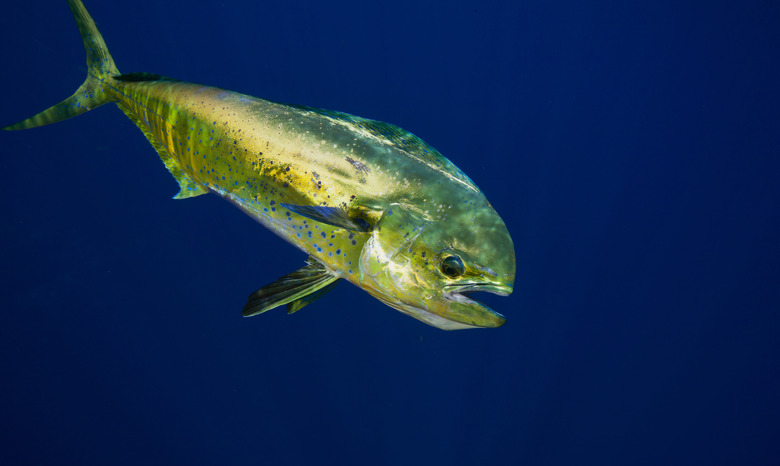What Kind Of Fish Is A Mahi Mahi?
Also called the dolphinfish, dorado or mahi, the mahi-mahi is a fish whose name comes from Hawaiian, meaning "strong-strong." Studying the appearance, diet, habitat, behavior patterns and uses of the mahi-mahi shows what kind of fish it is.
Appearance
Appearance
The mahi-mahi has a blunt head, forked tail and an iridescent yellow body. Spots of iridescent blue or green occur on its sides and back. It has an iridescent blue dorsal fin that goes from its head to a little before its tail and a fin on its underside that starts halfway down its belly an extends to its tail. It also has two fins on its underside that occur behind the underside of its head, and two fins that occur on its sides. Mahi-mahi average 3 feet in length, though they may grow up to 6 feet in length. The average weight of the mahi-mahi ranges from 8 to 25 pounds.
Lifespan
Lifespan
The lifespan of the mahi-mahi is around four years on average. Mahi-mahi are able to reproduce when they are around four to five months old. Spawning may take place every two to three days in the spawning season, which occurs year round in water above 75 degrees Fahrenheit. Spawning peaks vary with latitude.
Social Behavior
Social behavior of mahi-mahi ranges from living alone or in pairs to living in groups. Young mahi-mahi tend to live in groups while older mahi-mahi tend to live alone or in pairs.
Diet
Diet
Prey of the mahi-mahi depends on how big the mahi-mahi is and the season. Mahi-mahis eat man-o-wars, the trigger fish and the sargassum fish. The mahi-mahi also eats the young of such species as the tuna, mackerel, jack and billfish. Other things that the mahi-mahi eats include crabs, puffer fish larvae, trigger fish larvae, squid and octopus.
Home
Home
The mahi-mahi is a saltwater fish that makes its home in both tropical to subtropical waters, most commonly in water above 68 degrees Fahrenheit. In tropical areas they live year round, but in more temperate water they are seasonal, and show up when the water is warm. Large males live in open ocean while small male as well as females prefer to live in floating brown colored algea known as sargassum in the Atlantic Ocean.
Consideration
Consideration
Understanding the different ways in which people use the mahi-mahi gives insight into what kind of fish it is, in terms of what it means to people. The mahi-mahi is sold commercially for food, and the desired size for a commercial mahi-mahi is over 15 pounds. The mahi-mahi is also a fish hunted by sport fishers. The flavor of the mahi-mahi is described as being delicate or mild, and almost sweet. Mahi-mahi flesh should have a firm texture, and be a light shade of pink with red spots.
Potential Confusion
Potential Confusion
People also call another fish, Coryphaena equiselis, mahi-mahi along with other names such as pompano dolphin and also dolphinfish. Coryphaena equistis is smaller than the mahi-mahi, and has either pale yellow sides or silvery sides.
Cite This Article
MLA
Reinbold, Joan. "What Kind Of Fish Is A Mahi Mahi?" sciencing.com, https://www.sciencing.com/kind-fish-mahi-mahi-8536224/. 22 November 2019.
APA
Reinbold, Joan. (2019, November 22). What Kind Of Fish Is A Mahi Mahi?. sciencing.com. Retrieved from https://www.sciencing.com/kind-fish-mahi-mahi-8536224/
Chicago
Reinbold, Joan. What Kind Of Fish Is A Mahi Mahi? last modified March 24, 2022. https://www.sciencing.com/kind-fish-mahi-mahi-8536224/
